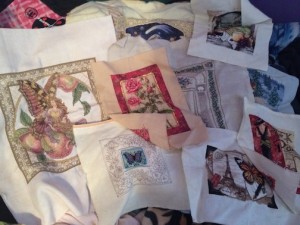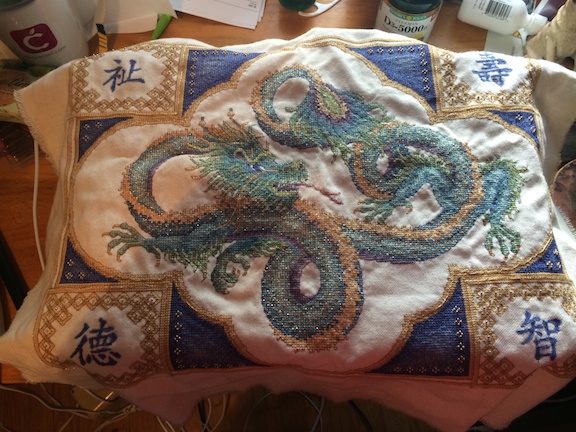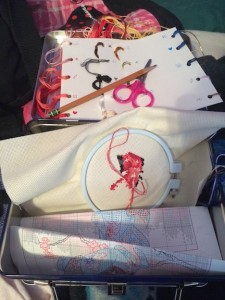So I have an embarrassing thing about myself I want to confess. I have an incredibly terrible and subversive hobby. I have been living in fear of people finding out about it and judging me. Here goes…
One of my favorite hobbies is cross stitching.
At the point, you might be wondering why I think this is some subversive thing to confess to. I will tell you why.
I have been cross stitching since I was seven. Pretty much my whole life I have been lead to believe this is something I should be embarrassed about.
My father would continually tell me that I should stop my cross stitching hobby and take it back up again after I retire. Looking at how tiny all the holes and the patterns are, I am highly skeptical that this is a good course of action.
I would bring my cross stitching to school to do during study halls and I would be constantly ridiculed by my classmates for doing it. So, like a good teenaged girl, I caved to peer pressure and hid my hobby away.
When I got married I had several very large and complex pieces that I worked years on framed. My husband wouldn’t let me hang them in the house for several years because he hated them. I still have a multitude of projects that I have finished and thrown into a bag that is slowly getting larger and larger over the years.
I have always felt like I was a weird, socially aberrant person because I have had a fascination with filling in little boxes with color and making a pattern out of them. I hide my carefully organized and structured projects in metal lunch boxes and pray that no one asks me what is inside.
So what does this have to do with anything?
Over the weekend I attended CocoaConf Columbus. Our first keynote speaker was Mark Dalrymple. During his excellent keynote, he talked about people embracing their hobbies. One of the hobbies he threw out was cross stitching. This threw me for a loop. Cross stitching has fallen out of favor over the last ten years. Also, this was a tech conference! People don’t talk about sewing at a tech conference!
I have painfully learned over the years that tech people are not supposed to cross stitch. Back when I was less experienced, I would go to interviews and be asked what I did for hobbies. I would say I cross stitch and there would be an immediate reaction on the face of the interviewer. I could tell that they mentally determined that I was not a tech savvy person.
There is this stereotype that women who cross stitch (and it is mostly women) are usually stay at home mothers or elementary school teachers. I am a British history buff and one very painful memory I have was reading about an attempted coup of Mary, Queen of Scots. Mary was an accomplished needleworker. When she was locked up in the tower, one of her captors sneered at her that she would have plenty of time for her needlepoint now. Society see needlework as something inherently tainted. People who enjoy doing needlework can’t possibly be fit to do anything important like run a country. Leave that to the other people who are more able to take on that responsibility.
You don’t see a lot of tech people talking about their cross stitching projects. Hell, knitting is much more socially acceptable than cross stitch! That might be because a lot of men do it, but that is a topic for another time.
Cross stitching is a far more concentration heavy task than knitting is. Cross stitching, specifically counted cross stitch, requires a tremendous amount of organizational skills. I regularly complete projects that include fifty different shades of thread and can include over a hundred symbols that contain some combination of those colors. You learn very quickly to get organized or you give up. Over the years I have learned to organize my thread to prevent it from tangling or becoming confused.
Counted cross stitch also requires you to look at a symbol on a grid, translate that symbol into a color, and render it onto a fixed rectangular surface of squares. Does this sound at all familiar? It is very similar to the process that takes place on the computer to render an image, except instead of bits I am using thread. I have been a human fragment shader for 25 years.
Every skill that makes me a good programmer is a skill I learned from counted cross stitch. I learned to be patient while working on a very large project that takes several years. To give an idea of scale, the dragon picture in this post is a project that I draped over my 15-inch Mac Book Pro and the edges spill over the sides by several inches. I learned how to mentally break down the project into manageable parts so that I did not get overwhelmed and confused. I learned how to organize my space and my tools to optimize my time. I learned to “debug” my designs because no matter how hard you concentrate, you will make mistakes. If you just keep following the pattern like a robot, your design won’t render properly.
This weekend was the first time I brought a counted cross stitch project to a conference and worked on it while listening to a session. I find that I can focus far better while cross stitching than I can while I have a computer in front of me because I get so focused on the screen that I tune out what is being said. I have been told it is rude to cross stitch in class or at conferences even though it is not considered rude to chat on Twitter.
I want to thank Mark D. for giving me the courage to write this post. I am tired of feeling ashamed of a hobby that has been a large part of my life for 25 years that has given me all the tools I need to continue to do what I want to do. I hope that one day people won’t be judged on their hobbies or how they decide to spend their free time, because often those are the things that shape us into the people we are.


